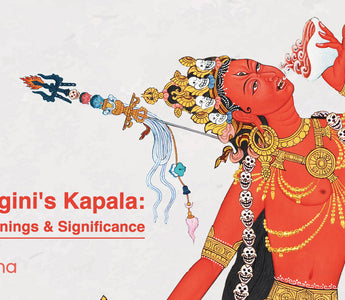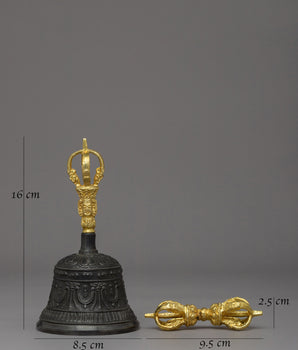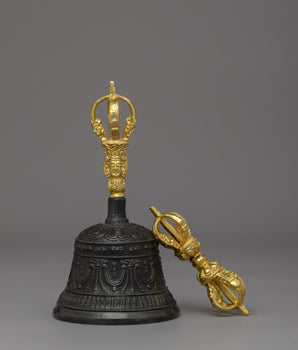Goddess Vajrayogini: Tantric Female Deity
Vajrayogini is a prominent and influential deity in Vajrayana Buddhism. She is a female manifestation of enlightened energy, frequently carrying a kapala skull cup filled with blood, representing the transformation of common aspirations into ultimate spiritual accomplishment. She is also linked to the Chakrasamvara tantra, one of the most important tantric practices in the Vajrayana tradition. Vajrayana Buddhists may meditate on Vajrayogini to achieve enlightenment.
What is Kapala Skull Cup?
The Skull cup, also known as Kapala or Thopa, is held in the left hand by Dakinis - feminine emanations of wisdom that accompany us on the spiritual path - is a visual depiction of the transience of the human body, and thus the Buddhist doctrine of impermanence. Impermanence is one of the fundamental Vajrayana Buddhist teachings. The skull cup is created from the crown of a human skull and serves as a ritual vessel for many other Vajrayana deities, including wrathful protectors, yidams, mahasiddhas, and yogis. Kapala, as a ritual vessel, incorporates the symbolism of the Vedic sacrifice clay pot, the Lord Buddha's begging bowl, and the sacred vase of bodhisattvas. It is said to symbolize the impermanence of life, the reality of death, and the transience of all things.

Click here to view our hand-crafted Tibetan Kapala Skull Cup
The significance of the kapala in Buddhism lies in its symbolism. The skull represents the reality of death and the impermanence of life, reminding practitioners of the preciousness of every moment. It also serves as a reminder of the ultimate goal of Buddhism, which is to achieve liberation from the cycle of reincarnation and reach the state of enlightenment. In tantra, it is used as a container for offerings such as tea, alcohol, and other substances. It symbolizes the transformation of impurities into wisdom and our negative emotions, such as anger and attachment, into positive qualities like compassion and wisdom.
Additionally, it is also considered a symbol of the union of wisdom and compassion, a reminder of the ultimate goal of Buddhism, which is the attainment of enlightenment for the benefit of all sentient beings. It is also a reminder that we are all interconnected and that the impermanence of life should not be feared but embraced as an opportunity for spiritual growth and development.
The symbolism of Kapala reveals various facets of the nature of the Dakini. Their energetic and vibrant essence matches nature's rhythmic flow. Nature's cyclical processes express the natural flow of life and human existence. Women are prone to experience the Earth's cyclic processes because they are compelled to refresh their bodies through menstruation every month. Most faiths regard women as "ritually impure" during their monthly cycle, and all sacred actions are forbidden to her at this time.
Ritual Implementation of Kapala

Click here to view our Hand-Painted Dakini Thangka
As the libation vessel of the Vajrayana practitioner, the skull cup parallels the clay pot ('Kumbha' in Sanskrit) of the Vedic sacrifice, the alms bowl of the Buddha, and the sacred water vase ('Kalasha' in Sanskrit) of the bodhisattvas. As a receptacle for sacrificial offerings presented to wrathful deities, it parallels the precious tray containing auspicious substances-the jewels, flowers, or fruit offered to peaceful deities. In its most benign symbolism, as an ascetic's begging bowl or food vessel, the skull cup is a constant reminder of death and impermanence.
The fact that Vajrayogini is holding a kapala emphasizes the tantric nature of her practice and the importance of transforming everyday experience into spiritual realization. It also reflects her role as a yidam, a meditational deity who can help practitioners in their spiritual journey and attain the ultimate goal of Buddhism.
To sum it up, he kapala held by Vajrayogini carries a symbolic significance in Buddhism as a reminder of the impermanence of life, the transformation of impurities into wisdom, and the ultimate goal of Buddhism, which is the attainment of enlightenment for the benefit of all sentient beings.
Dakini, Goddess of Liberation

Many warnings to not be deceived by appearance can be found within Vajrayana Buddhism's wisdom teachings. What appears frightening and even horrific is not always wicked but may be present for our benefit. Nothing better exemplifies this principle than dakinis.
"The wrath of God is never evil. God gets angry because he loves people like a mother would love her child if someone were to harm it. There is something wrong if the mother never gets angry; it is safe to say that that is the unloving mother."
― Criss Jami
A dakini is a female incarnation of liberating energy. Because they symbolize emancipation, they are frequently represented naked and dancing. The Tibetan name for dakini is Khandroma, which translates as "sky goer."
In Buddhism, Dakini are female spiritual beings who are believed to be powerful and enlightened. They are often associated with wisdom, teaching, and spiritual guidance. Dakinis are considered to be powerful protectors and can also be thought of as messengers or guides of the highest spiritual teachings. They are said to be able to help practitioners on the path to enlightenment and can manifest in various forms.
In Buddhist tantra, legendary dakinis help a practitioner generate joyful energy, changing defiled mental states, or klesas, into enlightened consciousness. In Vajrayana iconography, prajna, or wisdom, is frequently shown as the feminine principle combined with upaya, or skilled methods, the masculine principle. Thus, the female Dakini's release is the boundlessness of sunyata, nothingness, which is the pinnacle of wisdom.
Dakinis perform various roles in Vajrayana and can be identified in multiple ways, although they are typically classified into four major types. These are the four types:
1. Secret
2. Inner
3. Outer
4. Outer-outer.
On a secret level, the dakini represents the finest condition of the mind as experienced intimately in ultimate tantra yoga. On an inner level, she is a meditation deity or yidam, an expression of the practitioner's most fundamental nature. As self-other dualities dissolve, the outer dakini manifests as a physical body, which may be the physical body of the practitioner who has realized himself as her. And the outer-outer dakini is human, possibly a teacher or yogini.
In Buddhism, Dakini are classified into several types based on different teachings and traditions. Each classification has its own unique characteristics and symbolic meanings. They can further classified into several ways, including,
-
Wisdom Dakini: These Dakinis embody the wisdom aspect of the Buddha's teachings and are associated with the tantra teachings of Buddhism. They are said to help practitioners understand the true nature of reality.
-
Action Dakini: These Dakinis embody the action aspect of the Buddha's teachings and are associated with the tantra teachings of Buddhism. They are said to help practitioners overcome obstacles and achieve their spiritual goals.
-
Protection Dakini: These Dakinis embody the protection aspect of the Buddha's teachings and are associated with the tantra teachings of Buddhism. They are said to protect practitioners from negative influences and obstacles.
-
Worldly Dakini: These Dakini are said to be ordinary women who have achieved spiritual realization and are able to help others on the path to enlightenment.
-
Dakini of speech: These Dakini are embodiment of the speech of the Buddha's teachings and are associated with the tantra teachings of Buddhism. They are said to be able to help practitioners to understand the meaning of the teachings of the Buddha.















